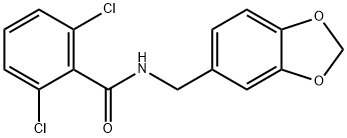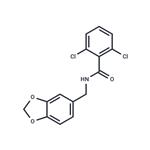Alda-1 has been used as an aldehyde dehydrogenase 2 (ALDH2) agonist:
- to study its cryoprotective effects on H2O2-induced Achilles tendinopathy in mice Achilles tenocytes
- to study its protective effects against alcohol-derived DNA damage in ALDH2 knock out mice
- to study its effects on cutaneous wound healing in mice
ChEBI: N-(1,3-benzodioxol-5-ylmethyl)-2,6-dichlorobenzamide is a carbonyl compound and an organohalogen compound.
alda 1 is an activator of aldehyde dehydrogenase 2 (aldh2).alda 1 increases activity of wild-type aldh2*1 and variant aldh2*2 (by ~2-fold and 11-fold respectively), capable of partly restoring mutant aldh2*2 activity, and protective against cardiac ischemia.
Alda-1 is an ALDH2 agonist; cell-permeable activator of both the wild-type ALDH2*1 and the asian E487K mutant ALDH2*2 forms of mitochondrial aldehyde dehydrogenase 2. ALDH2 is the oxidative enzyme, which removes the ethanol metabolite acetaldehyde and other aliphatic aldehydes. Also. ALDH2 is involved in bioconversion of vasodilator nitroglycerin to nitric oxide. Alda-1 increases acetaldehyde oxidation by ALDH2*1 (wild type) and ALDH2*2 9 Asian variant) approximately 1.5- and 6-fold, respectively. It appears that Alda-1 stimulates acetaldehyde oxidation by ALDH2 by improving NAD binding, but does not improve the nitroglycerin binding affinity of the Asian variant.
in the present study , alda-1 increased acetaldehyde oxidation by aldh2*1 and aldh2*2 approximately 1.5- and 6-fold, respectively, regarding gtn bioactivation and the effects of alda-1. to similar extent, alda-1 induced the esterase activities of both enzymes as the coenzyme nad. nad pronounced inhibition occurring at > 5mm, its the effect was biphasic. in the presence of 1 mm nad, alda-1 induced aldh2*2-catalyzed ester hydrolysis 73-fold, whereas the nad-induced activity of aldh2*1 was inhibited on account of 20-fold increased inhibitory potency of nad in the presence of the drug. aldh2*2 displayed 7-fold lower gtn denitrating activity and gtn affinity than aldh2*1, but the rate of nitric oxide formation was only reduced 2-fold. soluble guanylate cyclase (sgc) activation was more pronounced than with wild type aldh2 at saturating gtn. alda-1 caused slight inhibition of gtn denitration, and in the presence of either variant, gtn-induced sgc activation was increased. the present results imply that established aldh2 activities stimulated by alda-1, which improved nad binding but does not improve the gtn binding affinity of the asian variant. in addition, an unexpected discrepancy between gtn reductase activity and sgc activation was revealed, which suggested that gtn denitration and bioactivation may display independent pathways of aldh2-catalyzed gtn biotransformation [1].
alda-1 (a high-throughput screen yielded a small-molecule activator of aldh2, administered to rats before an ischemic event) reduced infarct size by 60%, most likely through the inhibition of the formation of cytotoxic aldehydes. thus, pharmacologic enhancement of aldh2 activity may be benefit to patients with wild-type or mutant aldh2 who are subjected to cardiac ischemia, such as during coronary bypass surgery [2].
[1]. beretta m, gorren ac, wenzl mv, weis r, russwurm m, koesling d, schmidt k, mayer b. characterization of the east asian variant of aldehyde dehydrogenase-2: bioactivation of nitroglycerin and effects of alda-1. j biol chem. 2010 jan 8;285(2):943-52.
[2]. chen ch, budas gr, churchill en, disatnik mh, hurley td, mochly-rosen d. activation of aldehyde dehydrogenase-2 reduces ischemic damage to the heart. science. 2008 sep 12;321(5895):1493-5.


